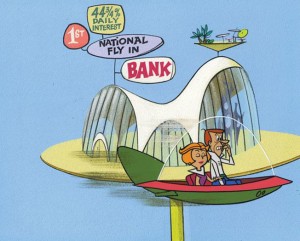After enormous success with The Flintstones, the folks at Hanna-Barbera decided to go in the opposite chronological direction, creating the futuristic space-age world of The Jetsons. The cartoon, which debuted in 1962, was intended to depict the year 2062, and The Jetsons were the very first television family to live in a world ahead of its time. From robot maids to flat-screen televisions, flying cars to video conferencing, the show’s creators envisioned a world that’s not too far off from where we are today.
Need Proof?
- George Jetson had: a “televiewer” screen (instead of a newspaper) where he could read all of his news.
- We have: desktop computers, laptops, iPads and cell phones.
- George Jetson had: RUDI, a system on his work computer that answered all of his questions. (RUDI stood for Referential Universal Digital Indexer).
- We have: Yahoo, Google, and Siri
- George Jetson had: video chat where he could see and speak with his boss from home,and his family from work.
- We have: Skype, video conferencing, and FaceTime.
- George Jetson had: Rosey,the household robot maid and vacuum cleaner.
- We have: iRobot vacuum cleaners.

Will this be the going interest rate in 2062?
Will this be the going interest rate in 2062? We may still have a few more years before we see flying cars, computer-programmed robotic chefs, and moving walkways in our homes, but we’re well on our way. Even the transportation industry uses technologies that are revolutionizing our industry. I’m proud to say that Matchmaker has already implemented the first two:
GPS Tracking: MacroPoint is a service that tracks the GPS location of a driver’s cell phone. If a driver accepts our request to track him, our system sends a text message at specific intervals (like every 4 hours). The system then automatically emails anyone who has requested updates with a map showing the driver’s progress. Drivers can even take photos of the Proof of Delivery (signed Bill of Lading) and send them to us, which expedites the billing and payment process.
Electronic Data Interchange (or EDI): This system lets computers “talk to each other”. For several years, we have used this system with select shippers to immediately transfer load tenders, send status updates and submit invoices. A huge time saver (once the system is set-up and our respective data fields are mapped onto each other), it allows shippers to send a file with shipment information from their system which then automatically populates into the appropriate fields in our system. The advantages include: no data entry, no clerical errors, and a solid communication trail should something go awry.
Flying Trucks: Okay. We admit it. There aren’t flying trucks yet, but there is a two-truck platooning system from Peloton Technology that reduces drag and saves on fuel by up to 10%. It uses forward-looking radar and intelligent braking to allow the trucks to travel closer together than would normally be safe. Trucks can only be paired in a platoon only if conditions warrant and only via Peloton’s cloud-based platooning operations center.
It’s amazing, heady stuff. Arthur C. Clarke said: “Any sufficiently advanced technology is indistinguishable from magic”, and I think he’s right. For most of us, technology is a lot like electricity–we cannot explain how it works, but we really appreciate being able to turn the lights on and off with just the flip the switch. Although I’ve spent a lot of time diving into the technologies mentioned above, when it comes to other advances I’ve decided to accept, adopt, and appreciate them without asking too many questions. But I am still curious about one thing:
If Apple decides to make a SmartCar, will it have Windows?
Recharge this weekend,
~Bob








